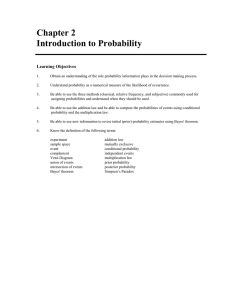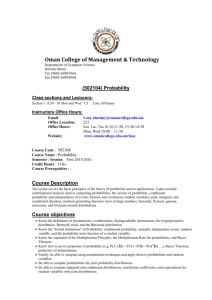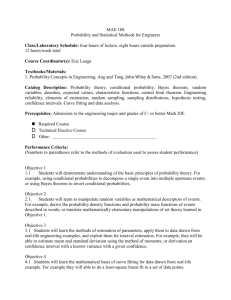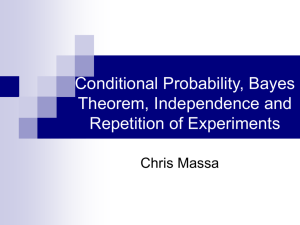1.017/1.010 Class 6 Conditional Probability and Bayes Theorem Conditional Probability
advertisement
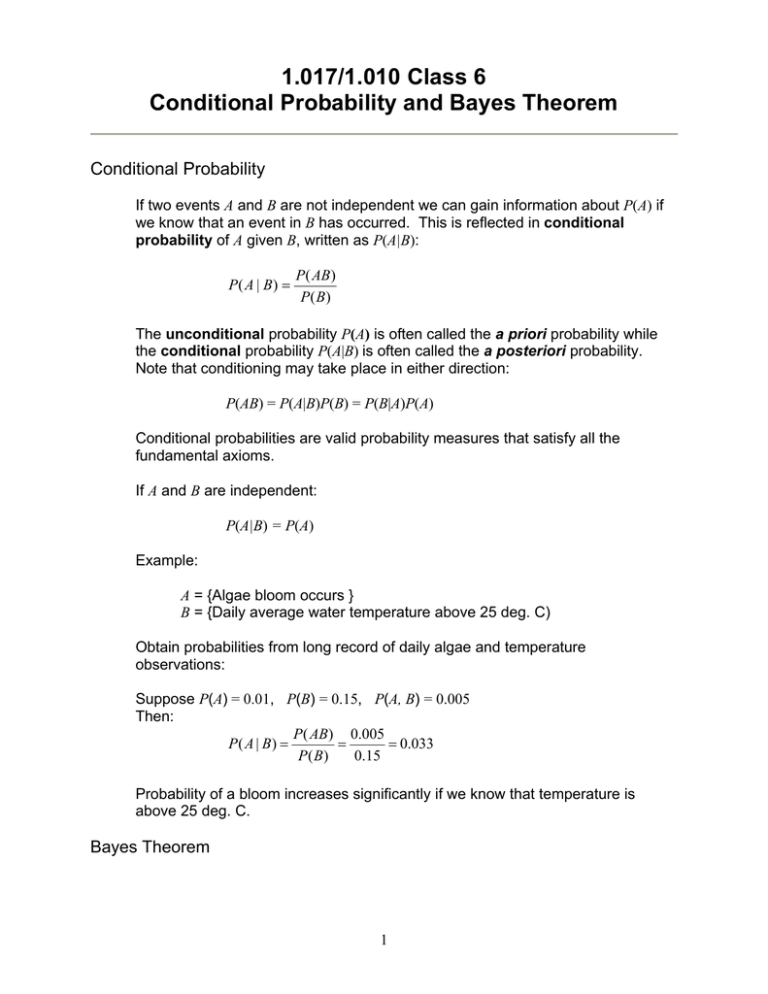
1.017/1.010 Class 6
Conditional Probability and Bayes Theorem
Conditional Probability
If two events A and B are not independent we can gain information about P(A) if
we know that an event in B has occurred. This is reflected in conditional
probability of A given B, written as P(A|B):
P( A | B) =
P( AB)
P( B)
The unconditional probability P(A) is often called the a priori probability while
the conditional probability P(A|B) is often called the a posteriori probability.
Note that conditioning may take place in either direction:
P(AB) = P(A|B)P(B) = P(B|A)P(A)
Conditional probabilities are valid probability measures that satisfy all the
fundamental axioms.
If A and B are independent:
P(A|B) = P(A)
Example:
A = {Algae bloom occurs }
B = {Daily average water temperature above 25 deg. C)
Obtain probabilities from long record of daily algae and temperature
observations:
Suppose P(A) = 0.01, P(B) = 0.15, P(A, B) = 0.005
Then:
P( AB) 0.005
P( A | B) =
=
= 0.033
P( B)
0.15
Probability of a bloom increases significantly if we know that temperature is
above 25 deg. C.
Bayes Theorem
1
Suppose that the sample space S is divided into a collection of n mutually
exclusive events (sets) called a partition of S:
S = { A1 , A2 , A3 ,..., An }
Ai A j = 0 i ≠ j
Consider an arbitrary event B in S, as indicated in the diagram below:
The event B can be written as the union of the n disjoint (mutually exclusive)
events BA1, BA2, ..., BAn :
B = BA1 + BA2 + ... + BAn
This implies total probability theorem:
P(B) = P(B|A1)P(A1) + P(B|A2)P(A2) + ... + P(B|An)P(An)
The total probability theorem and the definition of the conditional probability may
be used to derive Bayes theorem:
P( Ai | B) =
P( B | Ai ) P( Ai )
P( B | Ai ) P( Ai )
=
P( B)
P( B | A1 ) P( A1 )( B) + ... + P( B | An ) P( An )
Bayes rule updates P(Ai), given information on the probabilities of obtaining B
when outcomes are A1, A2, ..., An.
Example:
Consider a group of 10 water samples. Exactly 3 are contaminated. Define
following events:
Event
Definition
C
Sample contaminated
C'
Sample not contaminated
2
D
Contamination detected
D'
Contamination not detected
P(C) = 0.3 (based on 3 out of 10 samples contaminated)
Suppose sample analysis technique is imperfect. Based on calibration tests:
P(D|C ) = 0.9
P(D|C' ) = 0.4
Successful detection
False alarm
Bayes theorem (replace A1 with C, A2 with C′, B with D ):
P (C | D) =
P( D | C ) P(C )
(0.9)(0.3)
=
= 0.5
P( D | C ) P(C ) + P( D | C ′ ) P(C ′ ) (0.9)(0.3) + (0.4)(0.7)
Copyright 2003 Massachusetts Institute of Technology
Last modified Oct. 8, 2003
3

